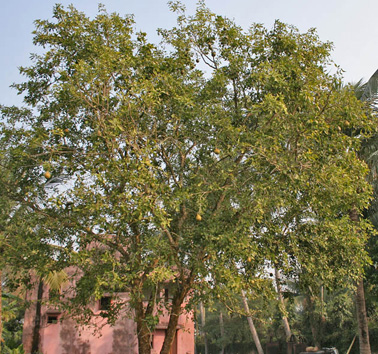|
Botanical Name:
Aegle marmelos
Bilva consists of dried stem bark &/or dried root of Aegle
marmelos Corr, Family Rutaceae
Common Name(s) in English & Indian Languages
Sanskrit: Sriphal
Assamese: Bael, Vael
Bengali: Bela, Bilva
English: Bael Root, Bengal Quince
Guajarati: Bilivaphal, Bill, Bilum
Hindi: Bel, Bela, Sriphal
Kannada: Bilva
Malayalam: Koovalam
Marathi: Baela, Bel
Oriya: Bela
Punjabi: Bil
Tamil: Vilvam
Telugu: Maredu
Urdu: Bel
Botanical description:
TThe Bilva tree is slow-growing of medium size, up to 40 or
50 ft (12-15 m) tall with shot trunk, thick, soft, flaking
bark and spreading sometimes spiny branches the lower ones
drooping. Young suckers bear many stiff straight spines. A
clear gummy sap, resembling gum arabic exudes from wounded
branches and hangs down in long strands, becoming gradually
solid. The deciduous, alternate leaves, borne singly or in
2'S or 3'S, are composed of 3 to 5 oval, pointed, shallowly
toothed leaflets, 1 1/2 to 4 in (4-10 cm) long, ¾ to 2 in
(2-5 cm) wide, the terminal one with a long petiole. New
foliage is glossy and pinkish-maroon .Mature leaves emit a
disagreeable odor when bruised. Fragrant flowers, in
clusters of 4 to 7 along the young branchlets, have 4
recurved, fleshy petals, green outside, yellowish inside and
50 or more greenish yellow stamens. The fruit round,
pyriform, oval or oblong, 2 to 8 in (5-20 cm) in diameter
may have a thin, hard, woody shell or a more or less soft
rind, gray-green until the fruit is fully ripe when it turns
yellowish. It is dotted with aromatic minute oil glands.
Inside there is a hard central core and 8 to 20 faintly
defined triangular segments. With thin dark-orange walls
filled with aromatic pale-orange, pasty, sweet, resinous,
more or less astringent, pulp. Embedded in the pulp are 10
to 15 seeds. Flattened-oblong, about 3/8 in (1 cm) long,
bearing woolly hairs and each enclosed in a sac of adhesive,
transparent mucilage that solidifies
on drying.
Parts used:
Dried stem bark, dried roots
Major chemical constituents:
Auraptene, Coumarins, Glycosides
Therapeutic uses:
• Dysentery (Pravahika)
• Digestive impairment (Agnimandya)
• Disorders of small intestine (Grahaniroga)
|
|

|
|
|



